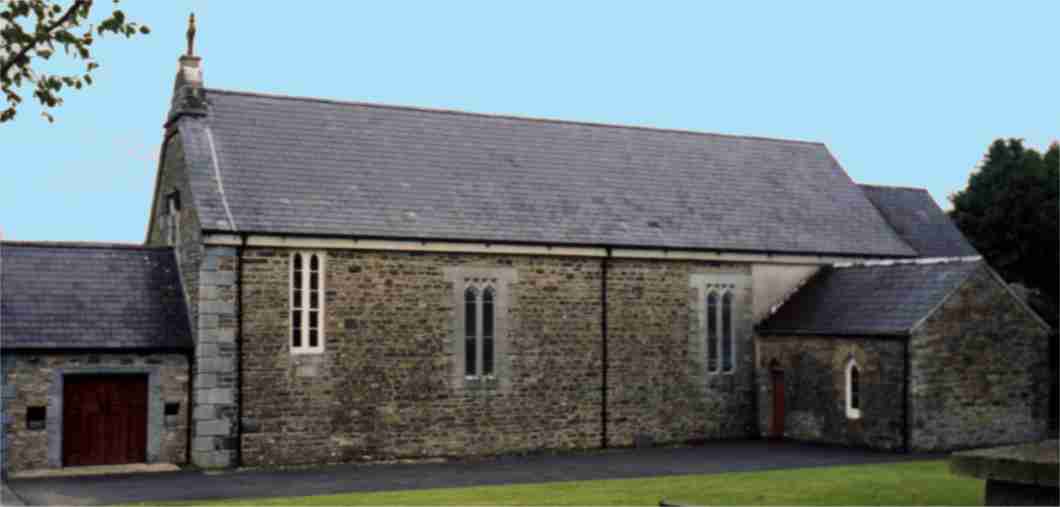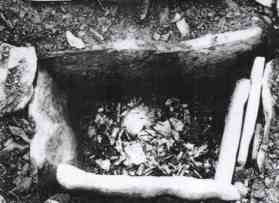

Templeglantine
derives its name from 'Teampull a Gleantain' meaning Church of the little glen.
Templeglantine is sometimes often known as Inchebaun meaning The white river
meadow. Its origins derive from a church supposedly built by the Knights
Templars who at the time also had links with Newcastle West. Historian Lewis
claim that a tomb of the Lacy family was non visible in 1840 and believe that is
was overgrown with ivy or destroyed. By then the gables had vanished and
sections of the side walls were left standing. It was around the same period
that the village as we know it today started to develop. Up until 1864
Templeglantine was part of Monegea so the town lands of Ballymurragh, Doonkenna,
Glendarragh, Meenoline North and south, Rathcahill, Sugar Hill, Templeglantine
East and West and Tulligoline North and South were then cut off from Monegea and
became the parish of Templeglantine.
It was at this time that Fr. James O'Shea P.P. in Monegea got transferred to Rathkeale. The present day church was built in 1829 during Fr. James Cleary's time as parish priest. It was then that the village began to grow up around this church. After that a primary school was built in 1843.
Present Day Church in Templeglanitne
The O'Macassa ( Anglicised Mackessy ) ruled the area up until the 12th century when the Norman Invasion brought the Earls of Desmond also known as the Fitzgeralds. The Earl became Gaelicised and had his own Gaelic poets. The Earl employed poets that belonged to the O'Dalaigh bardic family who in return were granted more or less what is Templeglantine today. The Desmond were defeated in 1583 and the areas of West Limerick became the jurisdiction of Sir William Courtenay, descendants became the Earls of Devon. The De Lacy family were also landlords in the are at that time. The Devon's were considered good landlords and ant tenant in the 19th century were able to finance the building of a house or a barn, were supplied with half the slates and timber by the landlords.
Culm of anthracite was mined between 1841 and 1871 in the northern part of the parish. When mining commenced the northern parts were sparsely populated, but by 1871 despite the decimation caused by the famine the population had more than tripled. It brought many families to the area but proved non-viable.
Another important source of employment in the district was the building of the Limerick /Tralee railway line which passed through the parish. This line is now closed. Templeglantine people used to boast that theirs was the only rural parish that had two railway stations. There was one at Barna, at the eastern end of the parish and one at the Devon Road was at the western end.
Bronze Age Burial in Rathcahill
In August 1985 while removing a field
fence, Mr Christopher Leahy uncovered a small stone built structure in Rathahill.
James Leahy, Christopher's father owned the land. The discovery under the advise
of Mr John Cussen, was reported to the National Museum of Ireland who in turn
sent two of their officers to the area to investigate the find.

The Leahy family partly guessed that the structure which had been found was a prehistoric grave of some description containing cremated human bones. The walls, floor and roof of the grave were formed of small slabs. Close to the grave there was an area which had been intensely burned, perhaps the site of a funeral pyre.
All the archaeological features were photographed and recorded and the contents of the grave were removed for further study and examination. A preliminary study shows that the remains were of two adult males. From the nature of the burial it was possible to assign a date from the earlier part of the Bronze Age roughly between 1,500 and 1,200 B.C. During the Early Bronze Age stone built chambers known as Cist Graves were widely used for burial all over the country but this wasn't common practice in Munster, but this Cist Grave is one of the most south westerly examples to have been uncovered.
The absence of ceramics from this site also argued for a date in the latter part of the Early Bronze Age, as the tradition of placing pottery in graves appears to have been abandoned towards the end of this period.
For Further Information Contact the National Museum of Ireland